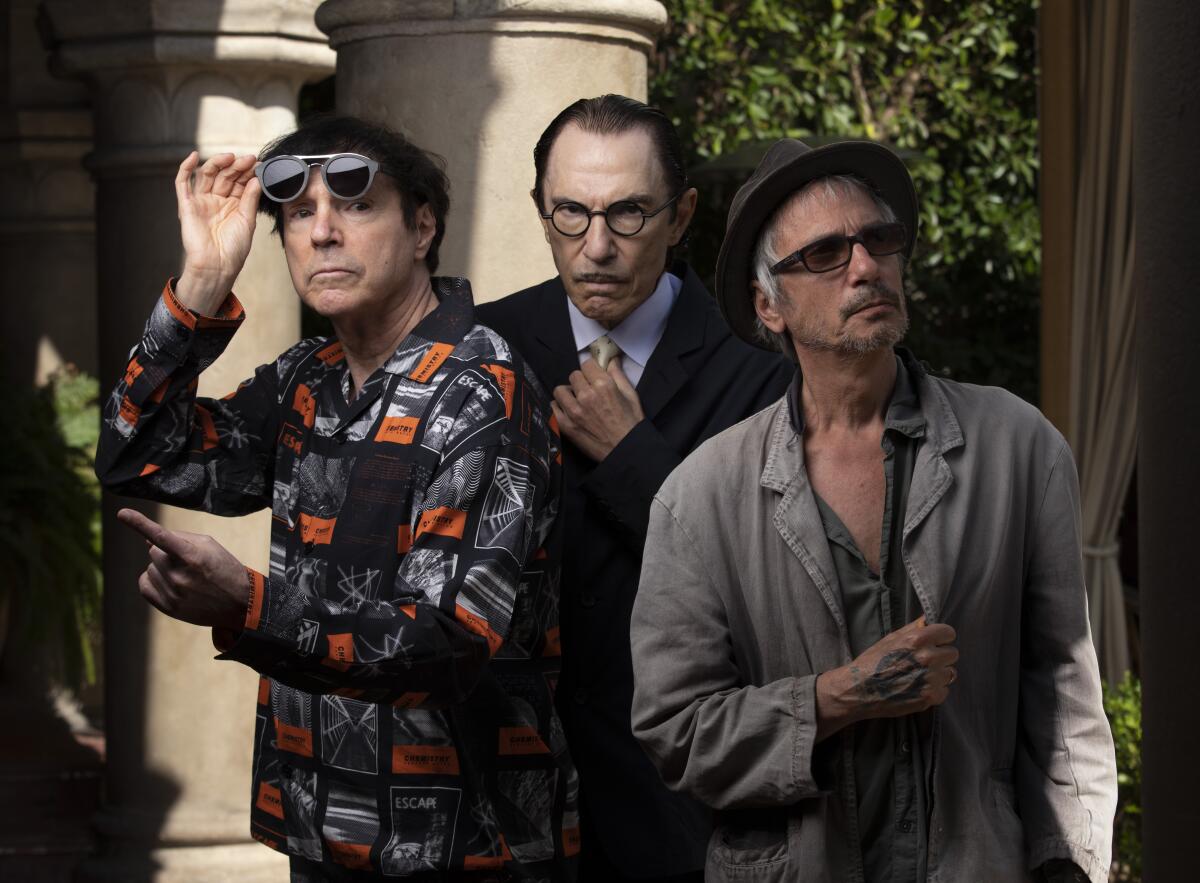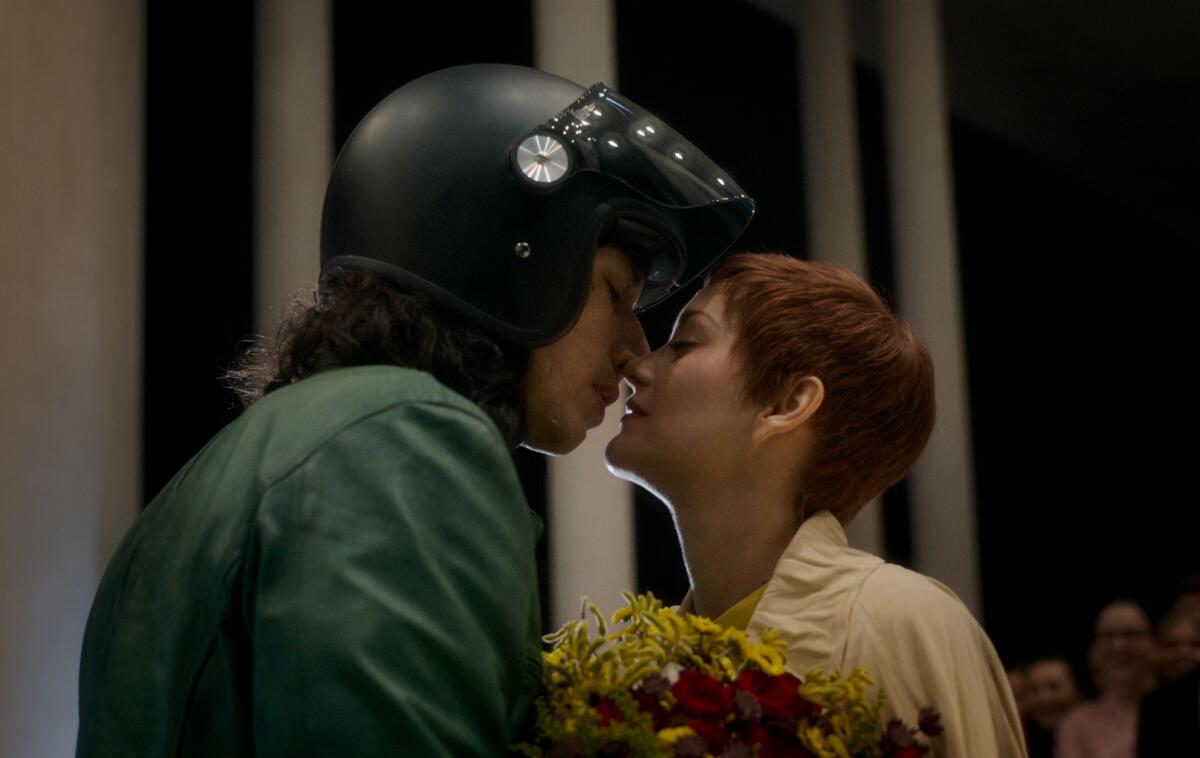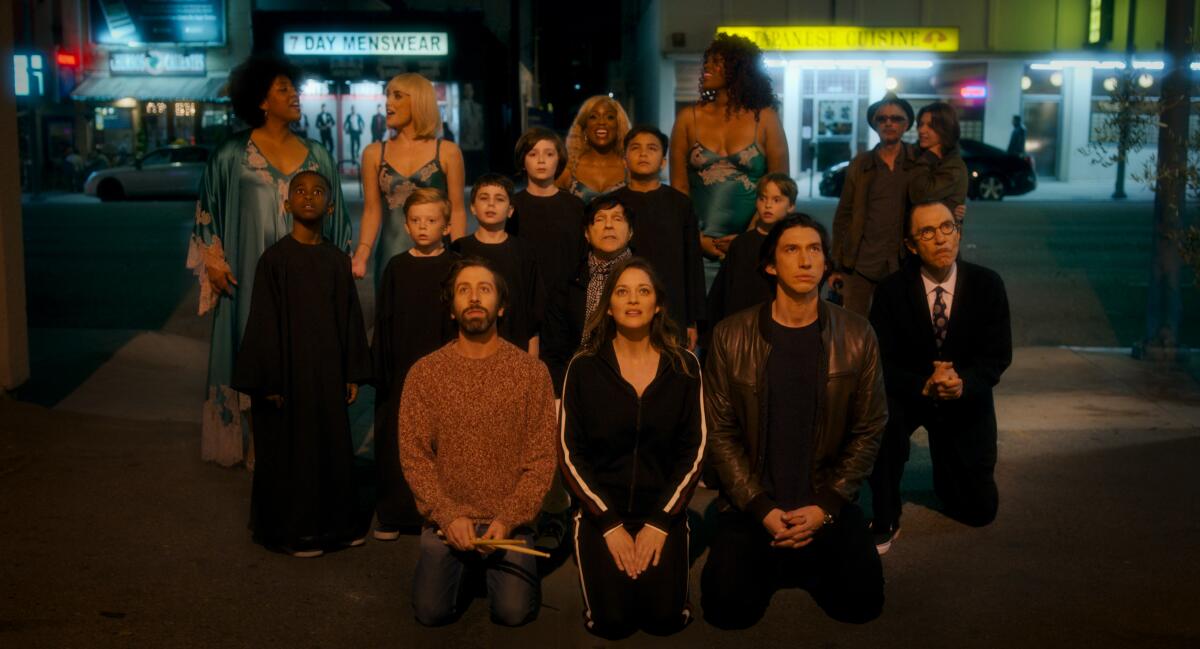Leos Carax and Sparks on sex, musicals, puppets and ‘Annette’

- Share via
The melodramatic musical “Annette” features the unusual collaboration between Ron and Russell Mael, better known as the band Sparks, and the enigmatic French filmmaker Leos Carax. The film is based on a story by the Maels, who also wrote the music for the film and worked with Carax on the lyrics.
In a career going back to the early ‘80s, Carax has made only six feature films, including 1991’s “The Lovers on the Bridge” and 2012’s “Holy Motors.” By contrast, over more than 50 years as Sparks, the Maels have put out some 25 albums. They were also the subject of Edgar Wright’s recent documentary “The Sparks Brothers.”
Streaming now on Amazon Prime Video, “Annette,” stars Marion Cotillard and Adam Driver as a pair of successful performers, she an opera singer and he a standup comedian, navigating the spotlight when they have a baby named Annette and all three of their lives take a dramatic turn.
The Maels were already tucked into a corner of a Hollywood hotel lobby for a recent interview when Carax entered the room. It was the first time the three of them had seen each other since the Maels accepted the best director prize on behalf of the absent Carax at the end of the Cannes Film Festival. Mimicking a reporter’s introduction to Carax, they introduced themselves with an affiliation as well.
“Russell Mael, Sparks.”
“Ron Mael, Sparks.”
Picking up on the their playfulness, Carax asked, “I get you confused. Which one sings?”

What was it like for the two of you accepting Leos’ best director prize at Cannes? Considering your love of movies that must’ve been a real thrill?
Ron Mael: I mean, we felt a little bit presumptuous. Just having the opening night film there was unbelievable, because we are such film fans, we’ve got all these books, you know, “The History of Cannes,” all this stuff. But it was kind of strange because Leos wasn’t there to win when he finally got honored by the Cannes Film Festival. So we felt a little bit presumptuous to be accepting the award on his behalf, we were kind of shoved up there and we were happy to do it. He deserves it, not only for “Annette,” but just as a lifetime achievement award.
Leos, what did winning that award mean to you?
Leos Carax: When I was younger and full of pride, I thought I wanted to be the one who deserves all the prizes, but doesn’t get any. And so I felt old. I guess that was my feeling.
Leos, that opening number, “So May We Start,” how did you come to conceive of it as this long unbroken take featuring Ron and Russell along with the actors?
Carax: Well, I thought let’s start with sound, and actually we hear it in the credits, we hear the first voice recording ever, which is “Au Clair de la lune,” and the idea was really to start with sound then project light on the screen. And so we were in this organic place, which is a recording studio in L.A. and then with the brothers and their band, we have all these electric sounds of plugging in. And I thought that we were going to start there. And as in my previous film, I’m going to be there with my daughter, because this is a reassuring way for me to start the film. Then I’m going to pass from me to Sparks to the actors and then at the end of the shot, the characters. So it’s going to be this continuity and from darkness to sound to light.
Ron Mael: We had a discussion really early on about our shared feelings about a modern movie musical about how — Leos brought this up first and we completely agreed — that sincerity was really primary as far as how the characters are projecting their feelings. There isn’t a distancing of what somebody is saying from how they’re really feeling. And that sounds like just a basic thing, but obviously there’s a lot of musicals that don’t follow that. And so it was really fortunate that we just, in a general way, had the same view of what it would be.
Russell Mael: Even down to things like, I don’t know if we talked about it ever or it was just kind of a given because we knew that we all have that same kind of taste, but choreography within a musical, I don’t think any of us necessarily gravitate towards breaking into song and then a hundred dancers and singers, singing in that way. There is subtle choreography in certain scenes, it’s choreographed in a certain way, but it’s not breaking into a dance routine. And there’s things that are where the movement is really specific but not in a traditional kind of Broadway or Hollywood musical way. And I think that was something that we all agreed on.

Even before the first screening of the film, based on the press notes, people have been talking about the fact Adam and Marion are singing during a sex scene. Are you surprised that people have reacted so strongly to that moment in the film?
Carax: No, because when you show people f— in a film people react. That’s the way it is. That’s the way it’s been since the Bible. This song, “We Love Each Other So Much,” was there from the beginning, the first demos I got and it’s a song we haven’t changed a lot. It’s this difference between cinema and if it had been a Sparks album. When I decided the first part is in the forest and they’re going to be on a motorcycle and then they’re going to f--- in the dark, then Russell and Ron [have] to make a kind of musical traveling, from the forest to the motorcycle and on. The song didn’t change, the melody, but you have these three chapters in this song. That’s one way we worked.
Ron, Russell, are you two surprised it’s become such a talking point?
Ron Mael: Maybe a bit, but I was surprised when I first saw it. I asked Leos, “When did you come up with that?” because I thought maybe it was like a couple of days before the shooting. And he said from the very beginning. So I thought, “Wow, a new unique way of staging the scenes, why shouldn’t it extend to a love scene as well?” I thought that was amazing, but not gratuitous. I thought it was really appropriate to the scene and the fact that it hasn’t been done before.
Russell Mael: Also, how Leos was directing it to be that way, Adam and the timing and all of him coming up, just so he’s able to sing his next line. I think it’s a really amazing scene. It’s beautiful. It’s incredible to see Adam when he pops his head up and is able to deliver that next line. Haven’t seen that in a movie. And I think that’s what’s so great about it.
I want to be sure to ask about the puppet for baby Annette. Leos, I’ve heard you say it was a series of “no”s, not wanting CGI, not wanting something animatronic, that led to the idea of a puppet. Can you talk me through the process of that decision? In a movie full of bold choices, it may be the strongest one.
Carax: I think it did come from all these “no”s. And also from the same thing as the music, I wanted her to be live. And she couldn’t be a real little girl because you can’t find a little newborn who can sing. But I wanted Adam and Marion and Simon to be able to touch her. And I [know] nothing about puppets and the problem was you’ve got to create that puppet. And I’m not a composer for the music, I’m not a sculptor, I’m not anything actually. I need people around me to make a puppet. So it took years to find the right puppeteer. When we started, the film was an American project at first and we started here, so I meet people here. Then we became a Japanese co-production and I worked with a woman puppeteer in Japan but I could never see Annette. Finally the one who saved the film was [Estelle Carlier] a young puppeteer in France.
Ron Mael: I mean, in our version, the kind of genesis of “Annette” was we wanted to do a live theatrical thing, but with a few characters so we could tour with it, and so the baby was just gonna be like sticking a $10 Toys R Us baby inside a pram and having it pretty dark, just hearing noise coming out. So we assumed it’s a film with a budget, they can afford a real baby. But the decision to make Annette a puppet was brilliant. Just the interaction between the actors was unbelievable. It adds a certain kind of positive unreality. I think it forces the viewer to accept Annette as real when you see the actors doing that as well. And then the puppeteers were just so skilled. It was pretty astounding to see the level of sophistication sometimes, but you’re always aware that it’s a puppet, there’s no disguising it.
Russell Mael: But then there’s other scenes like when Simon [Helberg]’s character is in the hotel room in Rio, it’s Simon having to not only act, not only singing, not only play piano, but also he’s manipulating the baby himself. There’s other scenes where the actors are actually having to manipulate the child. Even within the conceit of having it be a puppet, there’s different ways that they had to make the scenes work.
Then the final scene, when Annette becomes a real girl, the performance by Devyn McDowell is incredible. I think many grown adult actors would be intimidated by that scene with Adam Driver. What made you want to have that Pinocchio moment where the girl becomes real?
Carax: It might have to do with the fact that I have a daughter, I didn’t see myself leaving the film or ending the film without Annette. And I thought, OK, she’s got to go confront him. That came pretty late and I forgot why it came out, this idea. So it meant we had resolved the impossibility of Annette with the puppet, but then we had to find a 5-year-old kid who could sing and act and confront Adam, which, also impossible. So we were very lucky because we looked in Europe, finally our casting director [in L.A.] sent me images of this little girl. And she was the youngest, she had just turned 5 and she’s American. She had the shortest attention span. I mean, she has the worst in terms of production. And the producers said, we’re not bringing this girl to Europe. So it was a risk, but she’s wonderful.
Leos, during the press conference for the film at Cannes, you got up to go to the bathroom and that was sort of the end of the press conference. What can you tell me about that?
Carax: I’m never comfortable in those things, And I needed to piss anyway. At some point I get impatient.
You have a real confidence to just do things your own way.
Carax: Well, that’s what filmmaking is. I’ve never had box office success. So when I make a small film like “Holy Motors,” and it’s considered a small film, I have no problem. But each time I’ve been trying to do films that demand more money. And it’s a struggle. Since I started making films young I could say I’m used to it, except that I made so few that I never get used to it. It’s like starting all over again each time.
More to Read
Only good movies
Get the Indie Focus newsletter, Mark Olsen's weekly guide to the world of cinema.
You may occasionally receive promotional content from the Los Angeles Times.











